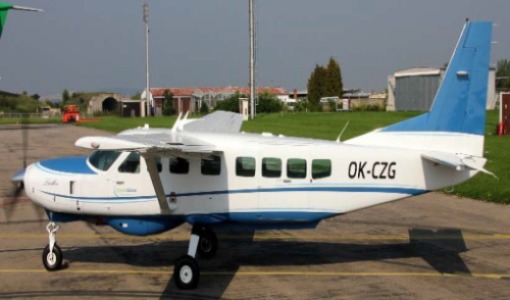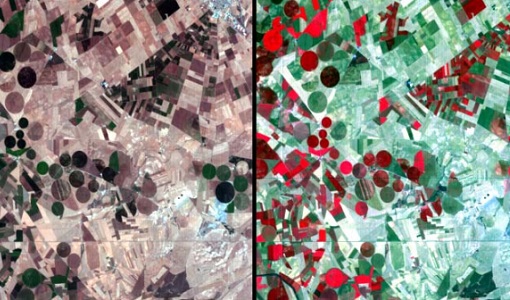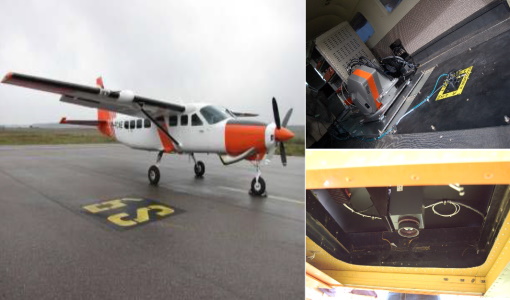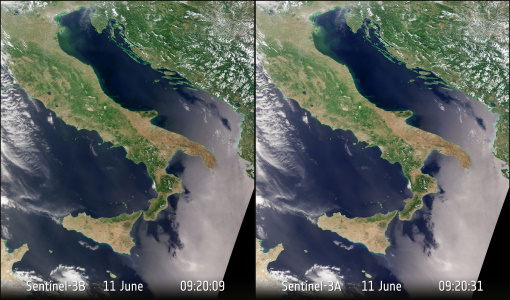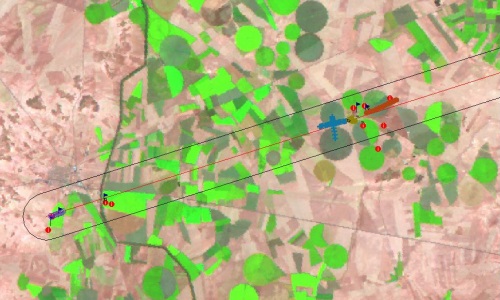- All Categories (101)
- Data (15)
- News (42)
- Missions (2)
- Events (7)
- Tools (6)
- Activities (2)
- Campaigns (14)
- Documents (13)
DATA
Discover and download the Earth observation data you need from the broad catalogue of missions the European Space Agency operate and support.
Data - EO Sign In Authentication (Open)
ICEYE ESA archive
The ICEYE ESA archive collection consists of ICEYE Level 1 products requested by ESA supported projects over their areas of interest around the world. The dataset regularly grows as ESA collects new products over the years. Three different modes are available: Spot: With a slant resolution of 50 cm in range by 25 cm in azimuth that translated into the ground generates a ground resolution of 1 m over an area of 5 km x 5 km. Due to multi-looking, speckle noise is significantly reduced Strip: The ground swath is 30 x 50 km2 and the ground range resolution is 3 m Scan: A large area (100 km x 100 km is acquired with ground resolution of 15 m). Two different processing levels: Single Look Complex (SLC): Level 1A geo-referenced product and stored in the satellite's native image acquisition geometry (the slant imaging plane) Ground Range Detected (GRD): Level 1B product; detected, multi-looked and projected to ground range using an Earth ellipsoid model; the image coordinates are oriented along the flight direction and along the ground range; no image rotation to a map coordinate system is performed, interpolation artefacts not introduced. The following table defines the offered product types: EO-SIP Product Type Mode Processing level XN_SM__SLC Strip Single Look Complex (SLC) - Level 1A XN_SM__GRD Strip Ground Range Detected (GRD) - Level 1B XN_SL__SLC Spot Single Look Complex (SLC) - Level 1A XN_SL__GRD Spot Ground Range Detected (GRD) - Level 1B XN_SR__GRD Scan Ground Range Detected (GRD) - Level 1B As per ESA policy, very high-resolution data over conflict areas cannot be provided.
Data - Project Proposal (Restrained)
ICEYE full archive and tasking
ICEYE full archive and new tasking products are available in Strip, Spot, SLEA (Spot Extended Area), Scan, and Dwell modes: Strip instrument mode: the ground swath is illuminated with a continuous sequence of pulses while the antenna beam is fixed in its orientation. This results in a long image strip parallel to the flight direction: the transmitted pulse bandwidth is adjusted to always achieve a ground range resolution of 3 m Spot instrument mode: the radar beam is steered to illuminate a fixed point to increase the illumination time, resulting in an extended Synthetic aperture length, which improves the azimuth resolution. Spot mode uses a 300 MHz pulse bandwidth and provides a slant plane image with a resolution of 0.5 m (range) by 0.25 m (azimuth); when translated into the ground, the products has 1 m resolution covering an area of 5 km x 5 km. Due to multi-looking, speckle noise is significantly reduced As an evolution of Spot mode, SLEA (Spot Extended Area) products are available with the same resolution of Spot data but a scene size of 15 km x 15 km Scan Instrument mode: the phased array antenna is used to create multiple beams in the elevation direction which allows to acquire a large area (100km x 100km) with resolution better than 15m. To achieve the finest image quality of its Scan image, ICEYE employs a TOPSAR technique, which brings major benefits over the quality of the images obtained with conventional SCANSAR imaging. With the 2-dimensional electronic beam steering, TOPSAR ensures the maximum radar power distribution in the scene, providing uniform image quality. Dwell mode: with the satellite staring at the same location for up to 25 seconds, Dwell mode is a very long Spot mode SAR collection. This yields a very fine azimuth resolution and highly-reduced speckle. The 25 second collection time allows the acquired image stack to be reconstructed as a video to give insight into the movement of objects. Two different processing levels can be requested: Single Look Complex (SLC): Single Look Complex (SLC) Level 1a products consist of focused SAR data geo-referenced using orbit and attitude data from the satellite and the scenes are stored in the satellite's native image acquisition geometry which is the slant-range-by-azimuth imaging plane and with zero-Doppler SAR coordinates. The pixels are spaced equidistant in azimuth and in slant range. The products include a single look in each dimension using the full transmit signal bandwidth and consist of complex magnitude value samples preserving both amplitude and phase information. No radiometric artefacts induced by spatial resampling or geocoding. The product is provided in Hierarchical Data Format (HDF5) plus a xml file with selected metadata Ground Range Detected (GRD): Ground Range Detected (GRD) Level 1b products consist of focused SAR data that has been detected, multi-looked and projected to ground range using an Earth ellipsoid model. The image coordinates are oriented along the flight direction and along the ground range. Pixel values represent detected magnitude, the phase information is lost. The resulting product has approximately square spatial resolution pixels and square pixel spacing with reduced speckle due to the multi-look processing at the cost of worse spatial resolution. No image rotation to a map coordinate system has been performed and interpolation artefacts are thus avoided. The product is provided in GeoTiff plus a xml file with selected metadata. Strip Spot SLEA Scan Dwell Ground range resolution (GRD) 3 m 1 m 1 m 15 m 1 Ground azimuth resolution (GRD) 3 m 1 m 1 m 15 m 1 Slant range resolution (SLC) 0.5 m - 2.5 m 0.5 m 0.5 m 0.5 m Slant azimuth resolution (SLC) 3 m 0.25 m 1 m 0.05 m Scene size (W x L) 30 x 50 km2 5 x 5 km2 15 x 15 km2 100 x 100 km2 5 x 5 km2 Incident angle 15 - 30° 20 - 35° 20 - 35° 21 - 29° 20 - 35° Polarisation VV All details about the data provision, data access conditions and quota assignment procedure are described in the ICEYE Terms of Applicability. In addition, ICEYE has released a public catalogue that contains nearly 18,000 thumbnails under a creative common license of radar images acquired with ICEYE's SAR satellite constellation all around the world from 2019 until October 2020. Access to the catalogue requires registration. As per ESA policy, very high-resolution data over conflict areas cannot be provided.
Data - Campaigns (Open)
CEFLES2
The objective of the CEFLES2 campaigns was to provide key reference data and background knowledge for the preparatory phases of the Sentinel‐2 and FLEX missions.
Data - Campaigns (Open)
SoyFLEX 2015
SoyFLEX 2015 took place over the agricultural area around Jülich, Germany and Rzecin wetland site, Poland
Data - Campaigns (Open)
SoyFLEX II 2016
The SoyFLEX II experiment was a repetition of an experiment that took place during the 2015 campaign in Germany.
Data - Campaigns (Open)
SPARC
ESA's SPectra bARrax Campaign (SPARC) activity was part of the preparatory study for a proposed ESA Earth Explorer mission called SPECTRA. The objective was to collect a CHRIS/PROBA reference dataset for SPECTRA-related studies.
Data - Campaigns (Open)
FLEX EU 2014
The FLEX-EU Campaign was carried out in 2014 over an agricultural area around Jülich, Germany, Latisana, Italy and forest sites in Czech Republic
Data - Campaigns (Open)
FLEX-US
The primary goal of the 2013 joint ESA/NASA airborne campaign was to record an unprecedented FLEX-like dataset containing maps of sun-induced fluorescence, hyperspectral reflectance, surface temperature, and canopy structure.
Data - Campaigns (Open)
FLEXSense 2018
The 2018 Fluorescence Explorer Sense (FLEXSense) campaign combined various field activities in preparation for the FLEX satellite mission.
Data - Campaigns (Open)
FLEXSense 2019
The FLEXSense 2019 campaign activities were undertaken in Germany and Italy with the goal of providing a complete set of high-resolution experimental data, including all relevant elements required for the preparation of the FLEX satellite mission.
Data - Campaigns (Open)
HYFLEX
This HYFLEX campaign aimed to deliver maps of sun-induced fluorescence recorded from airborne measurements using the approaches of the spaceborne FLEX mission.
Data - Campaigns (Open)
Sentinel-3 OLCI Tandem 2018
In 2018, a tandem campaign was conducted between the Sentinel-3A and 3B satellites to help test the future FLEX mission.
Data - Campaigns (Open)
PhotoProxy 2019
The Photosynthetic-Proxy Experiment campaign address relevant open aspects that are related to the quantitative assessment of vegetation photosynthesis and vegetation stress from space.
Data - Campaigns (Open)
SEN2EXP
In the SEN2EXP campaign, the data gap for broad leaf forests is addressed as suitable reference datasets of sufficient quality do not exist.
Data - Campaigns (Open)
SEN2FLEX
SENtinel-2 and FLuorescence EXperiment (SEN2FLEX) campaign combines different activities in support of initiatives related both to fluorescence experiments and Sentinel-2 initiative for prototyping of resolutions to meet mission requirements.

